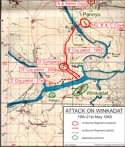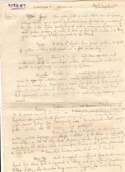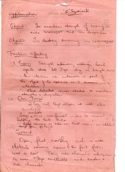Attack on Winkadat – 1st Battalion, The Burma Regiment - May 1945
I am indebted to Simon Jervis who provided the inspiration for this article and who generously shared the documents which form its basis. Simon also provided maps from his collection to support the text. Simon posted transcriptions of the documents in a thread on the WW2Talk forum dealing with the ‘Burma and India Theatre’. Simon is a well-known member of this forum, identified by the user name, ‘High Wood’.
The idea then followed to present the documents within the context of the actual events which ensued. The documents are plans for an attack on an enemy held village, Winkadat, and were drawn up in May 1945 by the 1st Battalion, The Burma Regiment. At the time, the Battalion was engaged in operations to clear Japanese troops from an area of the Sittang River bend, to the east of Waw.
_______________________________________
Winkadat - general location
(Map sheet contained within WO 172/7339)
Click image to open full size in new window
By April 1945, the Japanese in Burma had suffered a catastrophic defeat. A large body of troops from the Japanese 28th Army was left in the Arakan and in the Irrawaddy River Valley. Many were on the west bank of the great river, hoping to cross it and avoid the British cordon deployed to destroy them. To the south, others headed east and north where they subsequently took temporary shelter in the hills of the Pegu Yomas. The remnants of the 15th Army, survivors of the failed Japanese ‘March on Delhi’ in 1944, were heading south from the Kalaw area, through the hills between the Sittang and Salween Rivers. In the Sittang Valley itself, the 33rd Army had been pushed southwards by the IV Corps and by the end of April, those who had not been driven into the hills east of Toungoo were concentrated in the flat marshlands of the Sittang bend in the area of Waw and Mokpalin. Here, the Japanese hoped to keep open the escape route for those cut off in the Irrawaddy Valley and the Pegu Yomas.[1]
The British were determined to destroy the Japanese attempting to escape from Burma and the IV Corps was redeployed to deal with groups heading east from the Pegu Yomas and others to the south and along the coast. While the 17th Indian Infantry Division headed from Toungoo for Pegu, the 5th Indian Infantry Division was ordered to send its 9th Indian Infantry Brigade by air from Lewe to Pyuntaza, from where the Brigade would attack enemy troops in the Shwegyin-Waw area. The 1st Battalion, The Burma Regiment formed part of the 9th Indian Infantry Brigade and the last elements of the Battalion disembarked at Pyuntaza late in the afternoon of 29th April. By 1st May, the Battalion had two companies operating on the east bank of the Sittang River. Over the next few days, there were encounters with increasingly large parties of Japanese, who were either ambushed or brought under artillery and mortar fire. Between 8th and 10th May, the 1st Battalion, The Burma Regiment was re-deployed to the Sittang bend. Throughout the remainder of the month and well into June, the Battalion was engaged in clearance operations in this area. Almost every day patrols were sent out to look for the enemy and there were occasional clashes. Several larger scale operations, involving one or more companies and supporting arms, were planned and carried out to evict Japanese detachments occupying villages in the area. Towards the end of May, one such operation was planned with the intention to destroy Japanese troops reported to be occupying the village of Winkadat. It is this proposed operation that is the subject of the documents presented here.[2]
Winkadat: 19th-21st May 1945
(Map sheet courtesy of the Simon Jervis Collection)
Click image to open full size in new window
On 17th May, the 1st Battalion, The Burma Regiment moved to a village named Pannyo South in the battalion war diary, and identified as Pannyo on maps in use at the time. Patrols across the ‘chaung’ (the Burmese name for a waterway or stream) to the west were followed, between 17th and 19th May, by clearance operations supported by light tanks, artillery and air strikes, to clear the villages of Tawgyi South and Zibyugon. On the morning of 19th May, the Battalion’s positions were:
- ‘A’ and Administration Companies: in the village near Nyaungshke at map reference 322170
- Battalion H.Q, ‘A’ and ‘C’ Companies: Pannyo South
- ‘D’ Company: Zibyugon.
Pannyo South acted as the Battalion base of operations, from which patrols were sent out. ‘D’ Company was out to the south, at Zibyugon, and was separated from the main body of the Battalion by a ‘chaung’ running from the north-west. However, there was a ford across this ‘chaung’ just outside Pannyo and the company was reinforced by a section of the Battalion mortars and two sections of machine guns from the 17th Battalion, 17th Dogra Regiment, the 5th Indian Infantry Division machine gun battalion.[3]
By 19th May, many local reports had been received as to there being a number of Japanese hiding out in the village of Winkadat (referred to as Winkadet in the battalion war diary), on the far bank of the ‘chaung’ to the south of the area of recent operations. That morning, a patrol from ‘B’ Company was sent down to the ferry crossing across the ‘chaung’ opposite Winkadat, to see if these reports could be confirmed. Late in the morning, the patrol reported by radio that enemy soldiers were indeed present in Winkadat. In response, the Forward Observation Officer accompanying the patrol conducted an artillery shoot on the village. The patrol then returned to the ‘B’ Company position at Pannyo.[4]
Plan produced by the 'A' Company Syndicate (partial)
(Image courtesy of the Simon Jervis Collection)
Click image to open full size in new window
At 10:00 the next day, an air strike was called in on the village, after which a patrol from ‘D’ Company was sent to investigate the results of the strike. The patrol returned at 13:00 and reported that during the air strike, Japanese soldiers had been seen to run out of Winkadat to the east and west. Later that afternoon, ‘D’ Company was briefed to send out a patrol the following morning, to reconnoitre the crossing across the ‘chaung’ to Winkadat. The patrol set out early the next morning and at 05:30 reported on the condition of the crossing and the presence of an enemy post near Kabza. Late that same morning, the Battalion received reports from locals that between ten and twelve Japanese had been killed during the air strike on Winkadat the previous day.[5]
From the documents drawn up at the time, it seems that on 21st May, the Commanding Officer, 1st Battalion, The Burma Regiment, Lt. Colonel A.S. Lewis, requested three of his companies to prepare plans for an attack on Winkadat. He drew up an appreciation of the situation which included details of: the ‘B’ Company patrol and artillery shoot on 19th May; the air strike on the village on the morning of 20th May; the report of the ‘D’ Company patrol on the results of the air strike; and the report by the ‘D’ Company patrol sent out on the night/early morning of 20th/21st May, which included details of the possible crossing sites across the ‘chaung’. ‘A’, ‘B’ and ‘C’ Companies each set up a planning ‘syndicate’ to consider the options for an attack on Winkadat and to propose a plan. Each syndicate was to submit its appreciation and plan by 16:00 on 21st May.[6]
[Click here to view transcripts of the original documents.]
There is much in common between the appreciations prepared by each syndicate. It was appreciated that the ground to be covered was difficult and that detailed reconnaissance was essential to identify routes and obstacles. The approaches to any potential start lines for the attack all involved the crossing of a ‘chaung’, which the troops might wade in places but for which boats would be needed to carry the heavy equipment and ammunition and to bring back the wounded. All were mindful of the potential for heavy casualties to the assaulting infantry and the difficulties likely to be encountered in evacuating the wounded. The flat, open, marshy terrain meant any daylight attack would take place without the element of surprise and would most likely suffer heavy casualties on the approach to the village. The defenders had a good view of all approaches and benefited from the concealment and protection provided by the houses in the village. Clearance of Winkadat itself would lead to close fighting against an enemy likely to fight to the death and result in yet more heavy casualties among the attacking troops. All three syndicates proposed an approach to the start line under the cover of night. All proposed that the crossing over the ‘chaung’ be secured at night, with the assault forces moving across either under the cover of darkness or at first light when artillery support became available, with air support to follow later. One syndicate went further and proposed the infantry attack on the village also take place at night. All syndicates understood the need to integrate the battalion mortars and attached artillery and air support. One syndicate proposed the use of tanks to lay down suppressing fire on villages near to Winkadat. Such heavy reliance on supporting arms was normal practice at this stage of the war.[7]
Plan produced by the 'C' Company Syndicate (partial)
(Image courtesy of the Simon Jervis Collection)
Click image to open full size in new window
It is not known which, if any, of the plans was preferred by the Commanding Officer, and no attack on Winkadat took place subsequently. For the next two days, the Battalion remained at Pannyo, sending out a least one patrol to the area of Kyonye to the west of Zibyugon and Tawgyi South. No attempt was made to send troops across the southern ‘chaung’ to the Winkadat side. The 1st Battalion was now ordered to a new area and as a preliminary to this move, the next day, ‘D’ Company withdrew from the Zibyugon area to Pannyo South. Early on the morning of 23rd May, the withdrawal to Pannyo was complete when the two platoons of ‘B’ Company sent to Tawgyi South to cover the withdrawal of ‘D’ Company also returned to Pannyo. Later that morning, at 08:00, the Battalion began the march from Pannyo to Nyaungkashe and thence to the new area at Abya-Thaiktugon. Given the intention to withdraw from the Pannyo area, it may be that the plan for the attack on Winkadat was merely a training exercise for the Company Officers of the battalion. For whatever reason, the village was not attacked and thus the anticipated ensuing casualties were avoided, a blessing to all those who may have otherwise been involved.[8]
The full story of the 1st Battalion, The Burma Regiment can be viewed elsewhere on this site.
16 April 2018
[1] “The War Against Japan, Volume V, The Surrender of Japan”, Woodburn Kirby S., HMSO, 1969; “Sittang, the last battle”, Allen L., Purnell, 1973.
[2] The War Against Japan; War diary 1st Burma Regiment, WO 172/7801
[3] WO 172/7801
[4] WO 172/7801
[5] WO 172/7801
[6] Appreciation and plans for an attack on Winkadat by the 1st Battalion, The Burma Regiment, May 1945 (Simon Jervis Collection).
[7] Attack on Winkadat
[8] WO 172/7801



